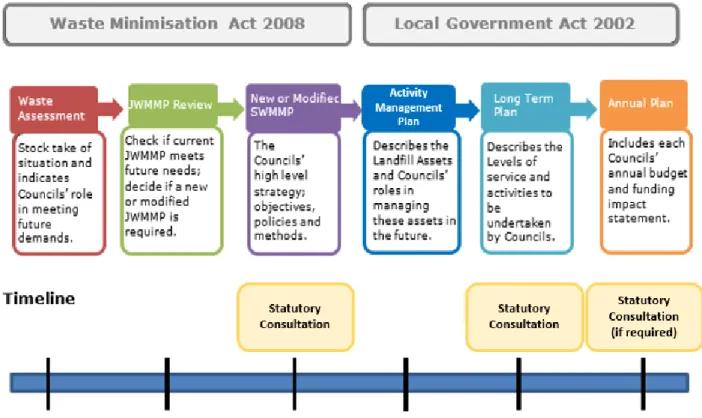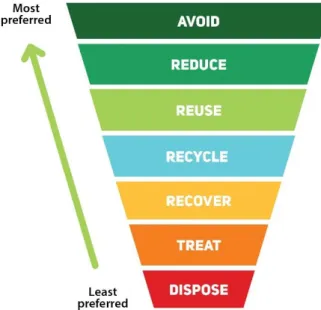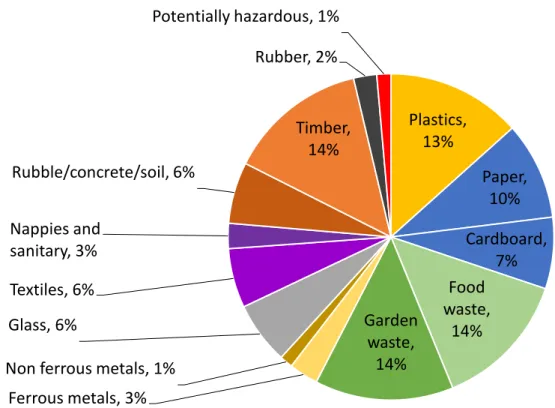In order to promote effective and efficient waste management and minimisation, the councils must adopt a waste management and minimization plan. This assessment identified future demands for waste management and minimization services and presented the Councils' options to address these demands. The assessment forms the basis of this Nelson Tasman Waste Management and Minimization Plan (this Plan).
Waste management and minimization services and all related activities are safe to operate and use. This plan sets the direction for waste management and minimization in the Nelson Tasman region for the next six years. When operational, it will replace the joint waste management and minimization plan adopted by the two councils in 2012.
A waste management and minimization plan provides direction for the development of a council's Long Term Plan, which allocates funding to implement it. A waste management and minimization plan must take into account the waste assessment and the New Zealand Waste Strategy 2010. The Waste Management Act section 50 (1)(b) requires that a waste management and minimization plan must be reviewed at least every six years.

Overview
Current Situation – total waste and diversion
What do the waste assessment numbers tell us?
How much material is diverted from landfill?
Existing Waste Services and Facilities
Waste is transported directly to landfill by commercial customers or through transfer stations and recovery centers. Part of the construction and demolition waste is processed directly by local contractors and then forwarded to reprocessors or to landfill. Understanding existing and planned services provides the basis for councils to determine the extent to which the region's needs are currently being met and what more might be needed to meet future demand.
Most of these activities take place outside of council services and therefore the amount of recycled materials cannot be accurately measured by councils. Around 6,500 tonnes of recyclables were diverted from landfill through kerbside collection services provided by councils in the 12 months ending June 2016. Councils recently introduced bins and the existing blue 60 liter bins were retained for glass.
Raw material recovery centers also collect car bodies, batteries, steel and tires, in addition to roadside recycling. Several other recycling companies operate in the region, but the municipalities do not have detailed information about the amount of material processed by these commercial sector recycling companies. The amount of recycling collected and diverted by the municipalities is about 10% by weight compared to the amount of solid waste that goes to landfill.
Councils support home composting and green waste separation as a way to increase landfill capacity. Municipalities encourage and accept some segregated green waste at the transfer station and resource recovery centers. Municipalities have limited data on the amount of waste processed in the region.
The councils jointly manage the York Valley and Eves Valley landfills through the council-owned Nelson Tasman Regional Landfill Business Unit. Waste from commercial operators is generally sent to resource recovery centers across the Tasman District, while most commercial and industrial waste is sent directly to landfill in Nelson City.
Forecasting future demand
The business unit was established on 1 July 2017, after which York Valley Landfill in Nelson became the only operating landfill in the region. Private waste collection operators also provide services to some households in Tasman and Nelson, including bins, wheelie bins, bags, bins or other collection services. Businesses often outsource their waste disposal to haulage companies who provide bins, bins or other arrangements.
Future opportunities to divert waste from landfill
The Councils’ Role in Managing Demand
Goals
Seven Guiding Principles
Method 1.1.3 The councils encourage the reuse of materials rather than the unnecessary consumption of natural resources. Method 1.1.4 The Councils promote community-led opportunities for reuse, ideas and innovation through the Council's communication channels. Method 1.1.4 The Councils remain committed to reducing food waste and home composting.
Methodology 1.3.2 Councils will provide tools for the community to assist in the delivery of community-led initiatives and programmes. Methodology 3.1.3 Councils will review New Zealand's data guidelines and incorporate these requirements into existing data collection systems. Method 3.1.4 The councils will investigate and may implement improvements to software and systems for collecting waste data at landfills, transfer stations and resource recovery centres.
Method 4.1.4 Councils will explore and be able to jointly manage and operate council-owned resource recovery facilities. Method 4.2.5 Councils will explore and possibly support the development of markets for the re-use or recycling of reclaimed construction and demolition materials, including waste exchange. Method 5.1.3 Councils will investigate the provision of future roadside services prior to establishing future services.
Method 5.1.4 Councils will consider the possibility of providing additional facilities in the region for the reception, collection and sorting of recycling. Method 5.1.5 Councils will review opportunities to offer organic processing facilities and services in the region. Method 6.1.2 Councils will work with central government to advocate product stewardship at a national level, including programs such as container deposit schemes.
Method 7.2.2 The Councils will investigate and may support options for the provision of additional services and facilities for hazardous or semi-hazardous waste. Method 7.5.2 The Councils will investigate options for pre-processing and diversion of material before landfill in conjunction with landfill capacity investigations. Method 8.2.1 The Councils will investigate solid waste by-laws and may propose to address issues identified in the Joint Waste.
Method 9.1.2 Councils will investigate and review health and safety impacts for all proposed methods to improve waste management and minimization before implementing new initiatives.

Overview of Funding Methods
Councils pay a waste disposal fee to the government (in their role as landfill operator via the regional landfill business unit) and each receive a 50% share of the levy collected nationally (in their role as an authority territorial). A significant proportion of this funding is provided by the Regional Landfill Business Unit, through the payment of 'local disposal tax' to councils. The National Landfill Levy received by Councils will be spent on matters to promote or achieve waste minimization and management in accordance with this plan.
The Councils can also apply for or apply to the disputable fund of the waste disposal charge. Details of the service delivery costs and sources of funding for each financial year will be included in each Council's Long Term Plan and Annual Plan.
National Waste Disposal Levy Spending
This is not an exhaustive list and will be reviewed on an ongoing basis.
Local Disposal Levy spending
Subject to this Waste Management Plan Councils are authorized to make such grants or cash advances on any terms and conditions they think fit and provided that any application for a grant or cash advance is supported by a description proposed activities for which money and budget. Performance indicators are intended to monitor the effectiveness of the objectives, policies and methods of the waste management plan. The amount of waste other than special waste generated in the Nelson-Tasman region that is disposed of in a Class 1 landfill.kg per capita per year for a typical resident population).
The amount of household waste collected by councils, a contractor on behalf of the council, or by private waste collectors (via kerbside or similar collections) from residential premises. kg per capita per year for the usually resident population of that district served by these collections). The amount of household waste collected from residential premises or similar waste deposited by other means by the owner of the house. kg per capita per year for the usually resident population of that district). Amount of household curbside recycling collected by Councils or private service providers from residential premises. kg per capita per year for the usually resident population of that district that has access to curbside recycling collections, less pollution).
Total waste diversion rate The total amount of material avoided or diverted by councils through council services. kg per capita per year for the ordinarily resident population of that district). Costs of illegal dumping Assess whether implementation of the waste plan leads to an increase in illegal dumping behaviour. The joint waste working group of the two Councils will continue to meet annually to review progress towards the objectives of the waste plan.
Membership of the working group will be by decision of the Nelson City Council and the Engineering Services Committee of the Tasman District Council. The Joint Waste Working Group will consider the performance indicators set out above and the implementation status of each method of the waste plan in its annual progress review. We acknowledge the hard work and support of the Joint Waste Working Party in the preparation of this document.
Household waste Waste from a household that does not originate entirely from the construction, renovation or demolition of the home HSNO Hazardous Substances and New Organisms. Reuse The further use of waste or diverted material in its existing form for the original purpose of the materials or products comprising the waste or diverted material, or for a similar purpose. Waste Assessment (WA) An assessment as defined by s51 of the Waste Minimization Act 2008; it provides background information for the waste plan by assessing the current situation in a defined area, in this case Nelson Tasman Waste Disposal Levy A levy imposed under the Waste Management Act.
WMMP / "this plan" waste management and minimization plan as defined in s43 of the Waste Minimization Act 2008.




